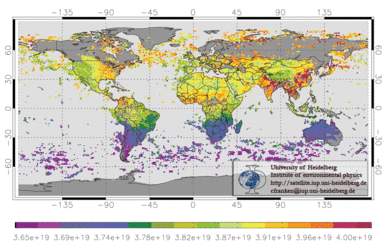

Water density distribution in Mars atmosphere
Data visualization of water density distribution with altitude in the atmosphere of Mars as a function of season, as measured by the SPICAM instrument on ESA’s Mars Express. The data covers eight martian years (Mars year 27 to 34), based on two dedicated campaigns per year. The data show that the vertical distribution of water vapour is highly variable with season and altitude. The results found that water vapour remained confined to below 60 km when Mars was far from the Sun but extended up to 90 km in altitude when Mars was closest to the Sun. The atmosphere also has a greater water density during southern hemisphere summer, enhanced by the planet’s closer proximity to the Sun.
In this visualization, brighter dots indicate a higher density of water (up to 1013 cm-3), darker indicate a lower density (5 x 109 cm-3). Data for two global dust storms are excluded from the data. See A. Fedorova et al (2021) for values and detailed description.





